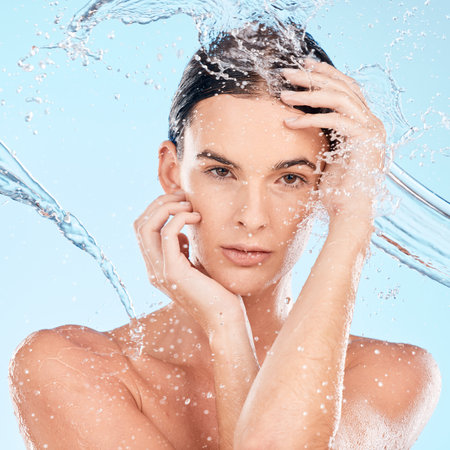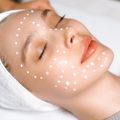1. Why Post-Filler Skincare Matters
Getting facial fillers is a popular way to smooth lines, add volume, and enhance facial features. But while the results can be immediate and impressive, taking care of your skin afterward is just as important as the procedure itself. After receiving fillers, your skin may feel tender, slightly swollen, or dry — and thats completely normal.
Facial fillers work by adding volume beneath the skin, but they can also temporarily disrupt your skin’s natural barrier and hydration levels. That’s why hydration and soothing care are essential during the recovery period. Proper post-filler skincare helps reduce inflammation, supports healing, and ensures your results look their best for as long as possible.
How Fillers Affect Your Skin
Here’s a quick overview of what happens to your skin after getting dermal fillers:
| Skin Response | Why It Happens |
|---|---|
| Sensitivity or tenderness | The injection process can slightly irritate nerve endings and surrounding tissue. |
| Mild swelling or redness | Your body reacts naturally to the needle insertion and filler material. |
| Temporary dryness or tightness | The skin barrier may be slightly compromised post-treatment. |
Why Hydration & Soothing Are Key
After fillers, keeping your skin well-hydrated helps restore balance and comfort. Soothing ingredients can calm any irritation and reduce redness. Together, these steps support faster recovery and help you get back to your daily routine with glowing results.
Benefits of Proper Post-Filler Skincare:
- Minimizes downtime: Helps reduce visible swelling or redness faster.
- Enhances results: Healthy skin shows off the filler’s effects more naturally.
- Prevents complications: Keeps the skin barrier strong and reduces risk of irritation or breakouts.
Pro Tip:
Avoid harsh exfoliants or active ingredients like retinol for at least 48 hours after treatment. Instead, focus on gentle hydration and calming products specifically designed for sensitive or post-procedure skin.
2. Best Hydrating Ingredients for Post-Filler Care
After getting facial fillers, your skin can feel a bit sensitive and dry. That’s why its super important to use the right hydrating ingredients to keep your skin calm, comfortable, and glowing. Here are some of the best ingredients to look for in your post-filler skincare products:
Key Ingredients to Look For
| Ingredient | What It Does | Why It’s Great After Fillers |
|---|---|---|
| Hyaluronic Acid | A powerful humectant that draws moisture into the skin. | Helps maintain hydration and plumps the skin without irritation. |
| Ceramides | Lipids that support the skin barrier and lock in moisture. | Reinforces skin’s protective layer, reducing dryness and sensitivity. |
| Glycerin | A gentle hydrator that attracts water to the skin. | Soothes irritated skin and keeps it soft and smooth. |
| Aloe Vera | Naturally calming and hydrating plant extract. | Soothes inflammation and provides light hydration without clogging pores. |
| Panthenol (Pro-Vitamin B5) | A moisturizing agent with anti-inflammatory benefits. | Reduces redness and supports healing after filler treatments. |
How to Use These Ingredients
You don’t need all of these in one product. Instead, look for serums or moisturizers that contain one or more of these ingredients high on the ingredient list. Apply gently to clean skin twice a day—morning and night—especially during the first week after your filler appointment. Avoid harsh exfoliants or retinoids during this time, as they can irritate the treated area.

3. Soothing Agents to Reduce Redness and Swelling
After getting facial fillers, it’s totally normal to experience some redness, swelling, or tenderness. The good news is that there are gentle yet powerful ingredients that can help soothe your skin and speed up recovery. Let’s take a look at some of the most effective soothing agents that are dermatologist-recommended and commonly found in post-procedure skincare products.
Aloe Vera
Aloe vera is well-known for its calming and hydrating properties. It helps cool the skin, reduce redness, and ease irritation. It also contains antioxidants and vitamins that support skin healing after filler treatments.
Arnica Montana
Arnica is a natural anti-inflammatory ingredient often used to minimize bruising and swelling. Many doctors recommend using arnica gels or creams right after injectables to help the skin bounce back faster.
Peptides
Peptides are short chains of amino acids that help repair the skin barrier and reduce inflammation. They also promote collagen production, which supports overall skin health after fillers.
Comparison of Soothing Ingredients
| Ingredient | Main Benefit | Common Forms | When to Use |
|---|---|---|---|
| Aloe Vera | Cools and hydrates irritated skin | Gel, cream, serum | Immediately after treatment |
| Arnica Montana | Reduces swelling and bruising | Cream, ointment, oral tablets | First 24–72 hours post-treatment |
| Peptides | Supports skin repair and reduces inflammation | Serum, moisturizer | Daily during healing phase |
Pro Tip:
If you’re looking for a product that combines several of these ingredients, check labels for medical-grade or dermatologist-formulated options designed specifically for post-injection care. Just make sure the formula is fragrance-free and non-comedogenic to avoid further irritation.
Using these soothing agents as part of your post-filler skincare routine can make a big difference in how quickly your skin heals and how comfortable you feel in those first few days after treatment.
4. Products to Avoid After Fillers
After getting facial fillers, your skin needs time to heal and adjust. While keeping your skin hydrated is important, its just as crucial to avoid certain skincare ingredients that can irritate the skin or even affect how long your fillers last. Here’s a breakdown of what to skip during the healing process.
Skincare Ingredients That Can Irritate Post-Filler Skin
Some active ingredients commonly found in skincare products can be too harsh on freshly treated skin. These ingredients might cause redness, peeling, or inflammation, which could interfere with the filler settling properly.
| Ingredient | Why to Avoid |
|---|---|
| Retinoids (e.g., Retinol, Tretinoin) | Can cause dryness, flaking, and irritation on sensitive post-treatment skin |
| Alpha Hydroxy Acids (AHAs) like Glycolic Acid and Lactic Acid | Mild chemical exfoliants that can sting or over-exfoliate treated areas |
| Beta Hydroxy Acids (BHAs) like Salicylic Acid | Penetrates deep into pores and may increase sensitivity around injection sites |
| Vitamin C (High concentration) | While generally good for skin, it can be too stimulating right after fillers |
| Strong Fragrance or Essential Oils | Can trigger allergic reactions or irritation on compromised skin barrier |
| Harsh Physical Exfoliants (scrubs with large particles) | Can cause micro-tears in the skin and disrupt healing tissue |
Treatments to Hold Off On Temporarily
Apart from skincare products, some treatments should also be paused for at least 1-2 weeks after your filler appointment. These include:
- Chemical peels: Too aggressive for healing skin.
- Laser treatments: May cause heat-induced swelling or bruising near filler sites.
- Microneedling: Invasive procedures can disrupt filler placement if done too soon.
- Facial massages: Can move filler before it settles fully into place.
When Can You Start Using These Again?
Your provider will usually recommend waiting around 7 to 14 days before reintroducing active ingredients. Always check with your injector before resuming your regular skincare routine. Everyone’s healing timeline is a little different, so it’s better to play it safe.
5. Top Recommended Products for Hydration and Recovery
After getting facial fillers, your skin needs extra care to stay hydrated, calm, and healthy. Choosing the right products can make a big difference in how quickly your skin recovers and how comfortable you feel during the healing process. Here are some dermatologist-approved serums, moisturizers, and masks that are especially helpful after filler treatments.
Best Serums for Post-Filler Care
Serums are packed with active ingredients that penetrate deeply into the skin. After fillers, its best to use hydrating and soothing serums that support skin barrier repair without irritating sensitive areas.
| Product | Main Ingredients | Why It’s Great |
|---|---|---|
| The Ordinary Hyaluronic Acid 2% + B5 | Hyaluronic Acid, Vitamin B5 | Deep hydration, lightweight formula, affordable |
| SkinCeuticals Hydrating B5 Gel | Hyaluronic Acid, Vitamin B5 | Professional-grade hydration, ideal for post-procedure skin |
| CeraVe Hydrating Hyaluronic Acid Serum | Ceramides, Hyaluronic Acid | Restores skin barrier while providing long-lasting moisture |
Top Moisturizers to Lock In Hydration
A good moisturizer helps seal in all the hydration from your serum and keeps your skin feeling soft and protected. Look for fragrance-free options with barrier-repairing ingredients.
| Product | Main Ingredients | Why It’s Great |
|---|---|---|
| CeraVe Moisturizing Cream | Ceramides, Hyaluronic Acid | Nourishes dry skin without clogging pores; non-irritating |
| Neutrogena Hydro Boost Gel-Cream (Fragrance-Free) | Hyaluronic Acid | Cools and hydrates inflamed or tight skin post-treatment |
| Eucerin Advanced Repair Cream | Ceramides, Urea | Smooths texture while calming dry or flaky spots |
Nourishing Masks to Soothe Skin
Masks can give your skin a quick boost of comfort and moisture—especially useful during the first few days after filler injections when your skin may feel tight or warm.
| Product | Main Ingredients | Why It’s Great |
|---|---|---|
| Avene Soothing Sheet Mask | Avene Thermal Spring Water, Glycerin | Cools redness and irritation; great for sensitive skin types |
| Pai Skincare Resurrection Girl Hydrating Mask | Tremella Mushroom Extract, Blue Tansy Oil | Naturally calming botanical ingredients; clean beauty option |
| Laneige Water Sleeping Mask (Hypoallergenic) | Squalane, Probiotic-derived complex | Nourishes overnight without heavy residue; gentle enough post-filler |
Treatment Tips:
- Avoid exfoliating products or retinol-based treatments for at least one week post-fillers.
- Patching a small area before full application is always a smart move—especially if you have sensitive skin.
- If you experience swelling or minor bruising, cool gel masks or refrigerated sheet masks can provide relief.


